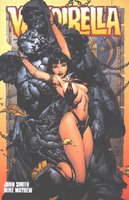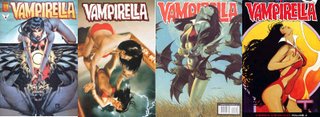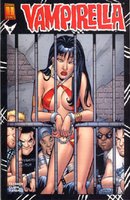
I can obsessively stew over things for weeks at a time, turning them around in my head and examining them, talking to myself about them and generally driving myself and my loved ones crazy. So it has been with a post I read over at Jog’s a few weeks ago, specifically a review of a Vampirella collection. See, at the time I read it, I was had also just discovered Andrea Dworkin’s web site which is, for one such as myself, a gold mine of brainfood (not as good for the heart, as it turns out, but necessary). I have also been making my way through Julia Kristeva’s essay “Women’s Time” which I can only presume influenced my reading of Jog’s post and the thinking that resulted. Folks know me as a comics nerd, but I am also quite the feminism nerd—though “nerd” maybe implies that my interest is more in scholarship and cataloguing than in justice, which, well, isn’t true, but I don’t know of any way to fully convey my enthusiasm for sexual justice other than to call myself a nerd for it, so there it is. Right.
My regular reading audience will know, of course, what Vampirella is, but for those who don’t know, or can’t infer from the title, it is a pulpy cheesecake horror comic best known for its protagonist of same name who is a busty, floss-clad, black-haired, often chained to something vampire alien woman. So Jog is reading along in this collection of comics from the mid 90’s, when he notices something kind of odd:
"But a little something’s missing - any actual sex or nudity, of course! Indeed, these stories will often go to laughable lengths (not just carefully positioned arms or shadows, but women walking around at an orgy wearing pasties) to avoid showing so much as a single nipple, despite their overwhelming desire to appeal to the most low-down needs of the readership. After all, this is a work where a sixteen-year old girl responds to the death of her father by squeezing her body into a skintight catsuit with the front zipper down to just above her navel, and where the title heroine at one point struts around in a revealing new costume just for the sheer hell of playing dress-up - she never actually uses it.[...] It’s the most puritanical work of sequential prurience I can readily think of at the moment, and that attitude even extends to the very suggestion of sexual activity. In the interview, Morrison makes mention of the "weird sex in the 90s" he’s been getting into, which attracted him to the book; funny then that the only characters in this book that enjoy any (carefully obscured) sex are the villains, who are then summarily massacred."

So why, if it is primarily meant to be a T&A book, does it so staunchly refuse to portray any actual nudity or sex? What is the goal, exactly, in keeping things covered up, despite the bodily contortions, the bindings, the violence? As Jog says,
"Actually, Vampirella manages to get chained down or tied up or otherwise restrained at least once in every story in this book, her dental floss-clad form writhing in chop-licking detail."At first blush, this might seem like a dissonance, like these things are working in contradiction with each other. But then I got to thinking about how, in the case of this character, the only clothing present has the explicit purpose of just obscuring the nipples and pubic area. And it was during this time that I ran across Dworkin’s essay “Vargas’ Blonde Sambos.” The essay itself is about WWII-era cheesecake good girl art, but I swear she could have been reading comics in the 90’s. For example, about the revealing clothing she says,
"There is a strategy, propagandistic, not artistic. That which is covered exposes the nakedness underneath."It is entirely possible that the wisps of clothing serve to focus attention on, rather than away from, the covered areas. And of course there is a long history in art, as in life, of women being forced to keep their bodies covered because of the sexual thoughts and entitlement of men; indeed it is rumored that when faced with the all-powerful nude woman a man loses all control. The solution to this problem (if indeed the problem exists, and it doesn’t) has never, at this point, involved restricting the options of men, but has caused all kinds of concern about what women can and can't do (as though, even if it were true, it was their problem). But anyway, the clothing… well, if they don’t show that skin, then it doesn’t count, right? But what they will do is show every possible inch of skin other than that, accentuating and objectifying the covered areas all the more. Referring again to Dworkin:
"Most of the drawings are not anatomically plausible but the idea is to draw attention to what is hidden while at the same time slandering the female form itself."Well, I expect any longtime comics fans are chuckling a bit at this point, because we do tend to go on about the implausible anatomies on display in comics all the time. But I think that Dworkin touches on something important here when she speaks of “slandering the female form”—there is an implicit contempt for the real, human body in these comic images. I'm reminded of that every time I see a drawing of a woman in a comic who is simultaneously displaying her ass and both of her breasts. People don't bend that way. There's also a good deal of head thrown-impossibly-far-back-in-exaggerated-yet-inexplicable-ecstasy shots. Also there are an inordinate amount of presenting-on-her-knees shots, you know, breasts jutting forward while she's on her hands and knees, sticking her ass up in the air, defying anatomy and sometimes gravity. Occasionally they've got the head thrown back in those, as well. Such depictions and deformities show a contempt for the human body and its limitations, or perhaps a contempt for women and their personal autonomy, a pushing, forcing, extending of the body beyond its shape for the pleasure of men. The bones of drawings don't break for the stretching; their faces don't wince in pain at being forced into any which position to display what the audience wants to see. The eyes are half open, the lips parted; occasionally a lip-licking tongue pokes out. They twist and contort and yet their sexualities are tightly controlled. Control is paramount. Control of the body's postion, control of the face's expression, control of the few inches of covered flesh. These are images of complete and total compliance and servitude.

Is the "bad girl," then, rather than a transgression against male authority, really an assertion of it (by relying not on the presence of actual, human women, but on the absence of the human woman through use of a graphic/narrative representation)? Or, as Dworkin puts it,
"If women existed in any one of the drawings, would men be similarly aroused; or is the absence itself the turn-on?"After all, the absence of a person means the absence of a will to assert, of a personal agency. So do these comics exist, in a way, as a means of working out these social/sexual control issues on representations of women, who can’t resist or express disfavor? Perhaps that's the answer right there to the question of why not any sex. There's no sex because sex and sexual gratification aren't the point or the goal at all. A hyperrealized sexuality is used as a means of control. Not control of actual human women, of course, but control of the representation, the narrative of women. We do live in a world that is very invested in its narratives and representations and perhaps to control those representations is to reach out into people's consciousness and shape their worldviews a little bit. It’s probably fortunate that the audience for these comics is relatively small, though what you see in the extreme here you’ll see to a lesser (but still visible) extent in more mainstream fare. However, with such a niche audience, we get to have a peak into the mind that creates the demand, for it must exist if these books do, and as Jog says,
"maybe they’re beholden to a certain set of subgenre tropes that lead to such a vehemently contradictory, virginally ‘outrageous,’ blood-soaked ‘n shackled half-naked women = good/nipples and affectionate touching = bad type of atmosphere."And you know, maybe they are, but why? Why do these tropes exist at all, and how did they become so powerful in that niche market? What is the origin of the contempt on display in these comics? And most frightening of all, how far do the traces of its influence extend to the rest of the industry, and indeed out into the culture at large?
Well, this has kind of been all over the place, but I think my main point is that, to answer the question of whether there is a tension between the hypersexuality and the sexlessness, I would say no, that rather than contradict each other these two things in fact work in concert to reinforce the same controlling and contemptuous narrative message:

7 comments:
Impressive analysis there, Dan. Control of what Class Woman represents as the real intent, not sex. Men who read Dworkin and then write stuff like this give me hope.
Very very interesting! These are the images of women you see everywhere in comics, anime, fantasy art, computer games.
"They twist and contort and yet their sexualities are tightly controlled. Control is paramount. Control of the body's postion, control of the face's expression, control of the few inches of covered flesh. These are images of complete and total compliance and servitude."
This made me instantly think of the immensely popular game designer/pin up artist Hyung Tae Kim. Here is an extreme example of his work: http://hyung-taekim.org/displayimage.php?album=21&pos=26
Excellent, excellent job. I never would have thought of using Dworkin to analyze Vampirella. I know my Gender and Culture professor will really get a kick out of this post.
Good job, Dan. It made me think of Sin City, a story in which I never really recognized the blatant hostility towards women until I saw the movie. I think that's because I had been so used to seeing it in comics that it didn't even cause a blip on my radar until I saw it in a different context.
I don't know if you're entertaining questions from those of us who are slow on the uptake, but if you are, could you explain what you mean by:
Is the "bad girl," then, rather than a transgression against male authority, really an assertion of it (by relying not on the presence of actual, human women, but on the absence of the human woman through use of a graphic/narrative representation)?
I'm not clear on what you mean about absence vs. presence - are you referring to the fact that representations of believable women are missing from the stories?
I think that absence refers to using an image that is such a monstrous distortion of body and of attitude of anything that might be considered real and saying that it represents a woman. I mean, what's with all of these images of heads being thrown back in the middle of a field, surrounded by bats? What's with the self-groping, or with the sultry glances while being accosted by groping hands, or while chained to that monument-thing? There are images of weirdly impossible bodily contortions, but yet no indications that there is anything pleasurable actually going on--there is no humanity on display--a human being is absent.
And then, of course, they are quite literally not human, i.e. they are drawings and fictions, fantasies. And this indicates that there are those who see women in this way, or would like to but can't with real women. But the snag is that real women are individuals with their own, self-determined responses, and that spoils the good time, hence the "need" for representations.
So I think absence, in this case, has space for several readings.
Hey Dan, nicely put! What strikes me is how cowardly this kind of thing is at its core - escapism in its ugliest form, escaping not just from dull day-to-day reality but from humanity itself, in a sense. Seems like this stuff gets more popular in direct proportion to women's prominence in society, too. I hear Playboy sales have declined in favor of Maxim and its clones, as if even Playboy-level reality, such as it is, is too much like dealing with a human being.
I think it's possible to make and appreciate this kind of stuff if it's done with a wink and a nod towards its own ridiculousness and a healthy dose of irony. I'm looking at the Coop devil-girl stickers and the copy of Junko Mizuno's "Hell Babies" I have in my studio here. Both are so full of retro-pop culture kitschy-ness and over-the-top sexuality and weirdness that I can't put them in the same league as Vampirella and her ilk. (And they're nowhere near as coy!)
I remember coming across some fashion industry commentary in a review of a popular sociology book back in, oh, the late '80s? early '90s? talking about how the point of skimpy costumes (specifically lingerie) was to highlight the forbidden and that for that reason, they were *more* titillating than unabashed nudity could ever be - exactly the kind of thing your analysis is tackling here, on a different medium.
The unnaturality of the "female body" [sic] in these "sexy" images is something else that's been discussed for a long time - there's a very precocious analysis of the phenomenon of men no longer finding un-airbrushed, naturally-hairy and un-made-up female bodies beautiful in The Screwtape Letters from the '40s, and while I jokingly talk about how we're being biologically sabotaged by the wasp-waisted Vespans, making humanity impotent by brainwashing human males into thinking that only physically-impossible physiques are sexually attractive, it's not really very funny to be stuck in it.
Post a Comment